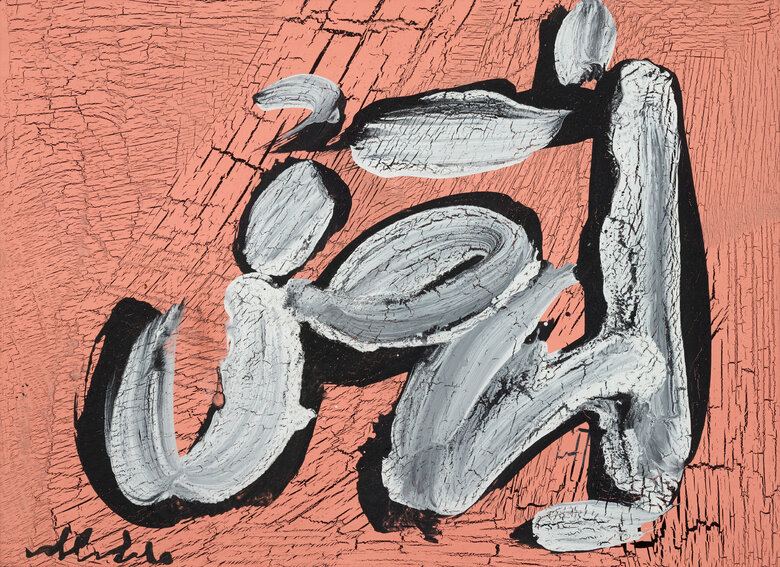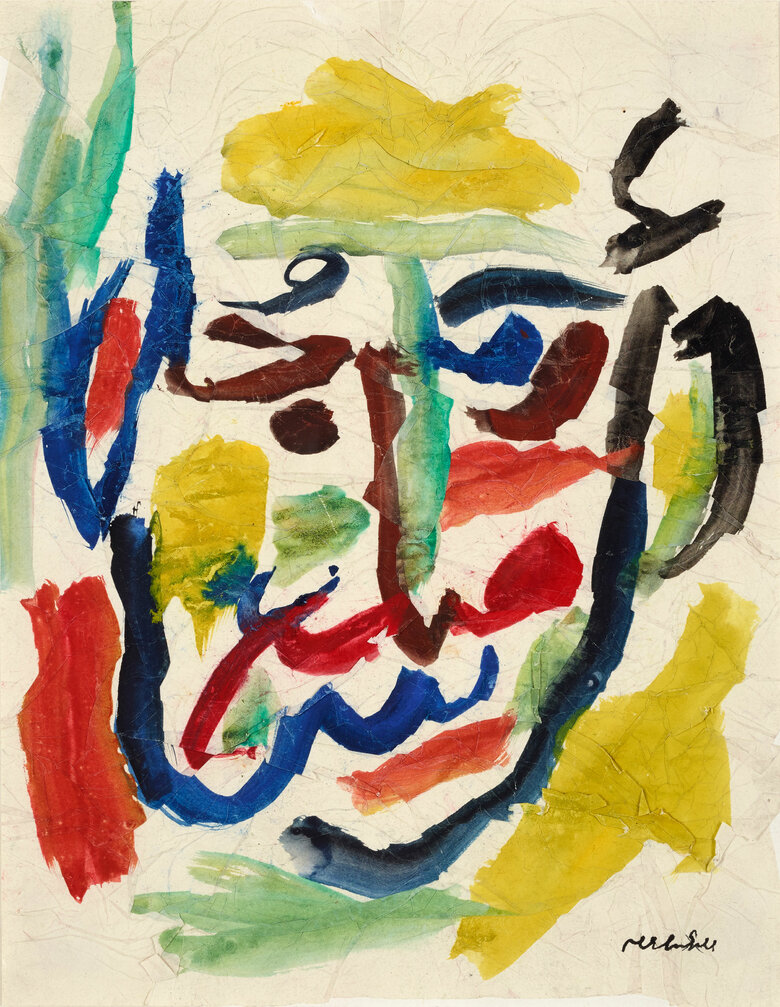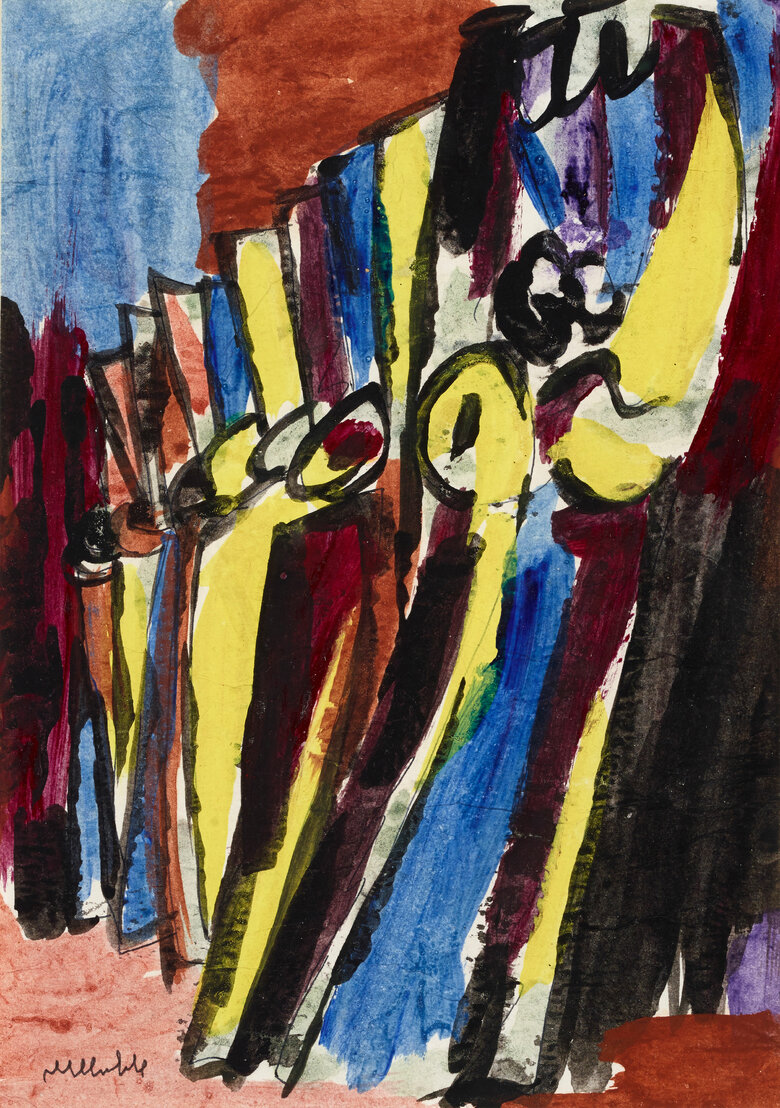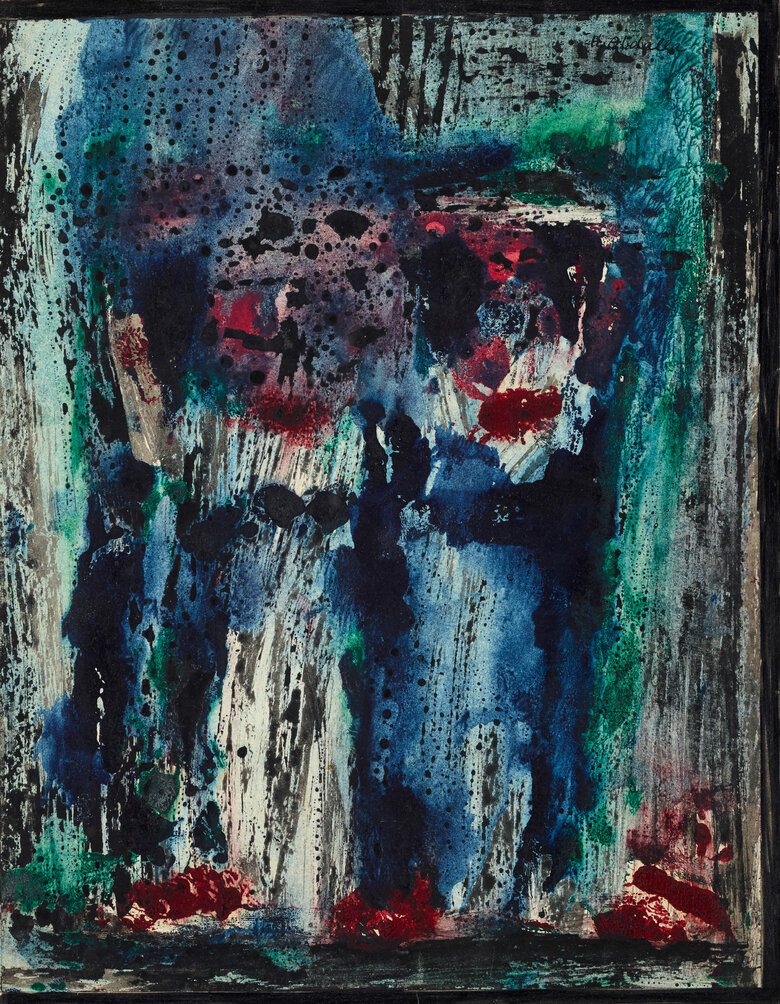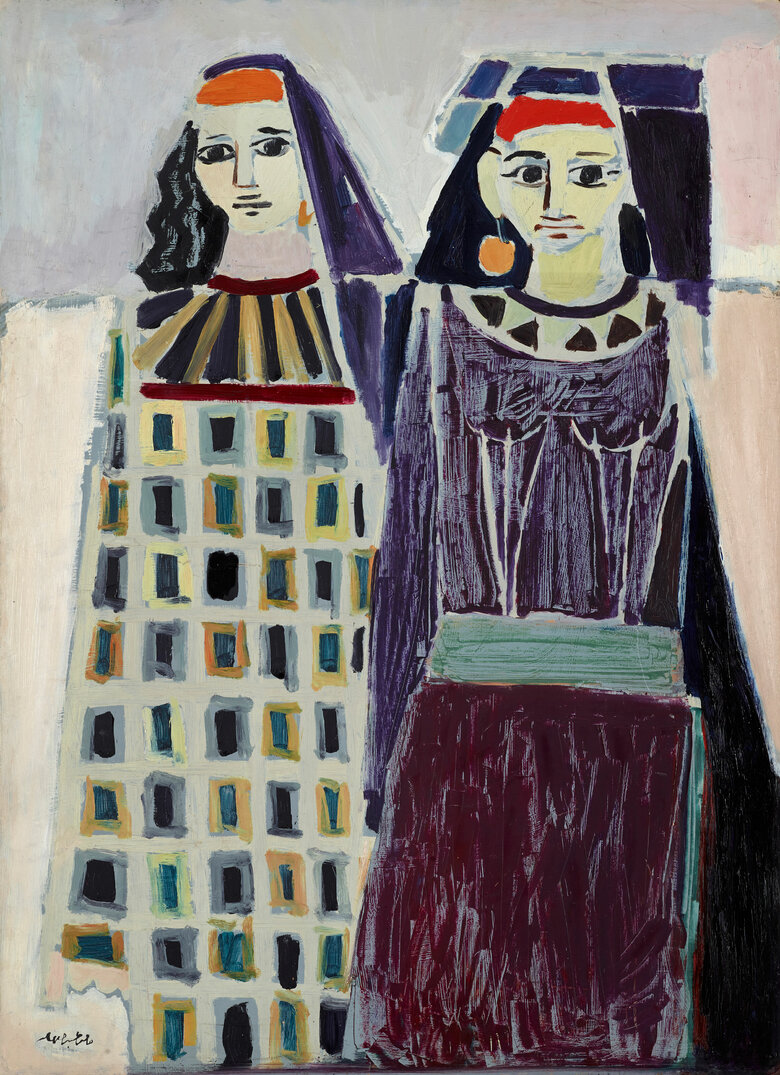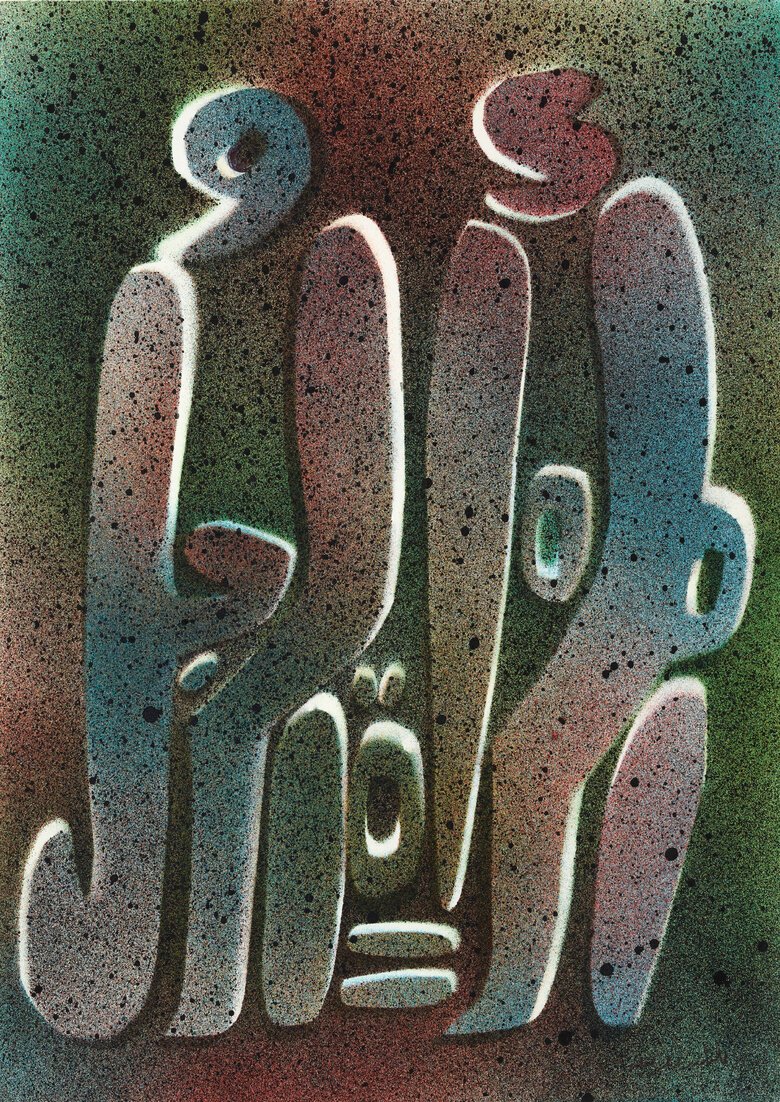Hamed Abdalla was born in Cairo in 1917 to a farming family. As a pupil in Qur’anic school, he was initially trained in calligraphy and later enrolled at the tuition-free School of Applied Arts...

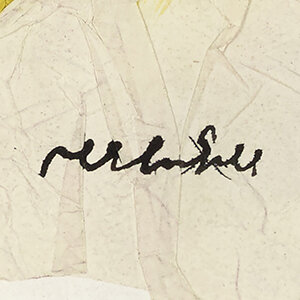
HAMED ABDALLA, Egypt (1917 - 1985)
Bio
Written by NATHALIE BSAT
Hamed Abdalla was born in Cairo in 1917 to a farming family. As a pupil in Qur’anic school, he was initially trained in calligraphy and later enrolled at the tuition-free School of Applied Arts in Giza. His parents supported his decision to study wrought iron there, hoping he would become a skilled artisan, but 15-year-old Abdalla quickly realized that his interest in art went beyond the purely decorative. Skipping the classes he found dull, he frequented libraries and zoological gardens instead and read about history, art history, and philosophy. He grew more and more unsatisfied with the material being taught in his classes, as pupils were only encouraged to copy the masters rather than expressing themselves artistically. When Abdalla finally dropped out of the School of Applied Arts, his father wanted him to find a job, but the young artist kept drawing against his father’s will. Father and son opposed each other so adamantly on this issue that the former cut the latter off, refusing him food; this only pushed Abdalla to pursue his passion with greater conviction. When he was denied admission to School of Fine Arts in Cairo due to his lack of academic experience, he did not give up; instead, he became a self-taught artist whose successful career defied the norms of the overwhelmingly bourgeois Egyptian art world.
Indeed, though Abdalla loved to learn and was constantly expanding his art historical knowledge, he sought to liberate himself from institutional constraints.
He disliked the system of arts education so vehemently that he refused several university professorships, teaching only at the art school he established in Cairo. This school only ran from 1942 to 1948, but in its brief lifetime, several prominent artists were trained there, including Tahya Halim and Inji Efflatoun.
In keeping with his anti-establishment philosophy, the artist preferred technical experimentation to rigid classical formulas and has ultimately been credited by critics with the conception of a new school of Egyptian painting. His style bears many of the hallmarks of abstract expressionism yet remains figurative, in conversation at once with European modernism and Egyptian artistic genealogy. His work depicts Egyptian society in black, white, and bright earth-toned acrylic paint that, applied to paper, creates a distinctive crumbling on the work’s surface. This adds a unique third dimension to the work and blurs the boundary between painting and sculpture. Furthermore, it could be argued that this stylistic choice documented the transformation and urbanization of the Egyptian landscapes he portrayed, its crackling resembling cracks in walls, smoke-like textures, dirt, and soapy oil spills.
Having exhibited in Egyptian galleries throughout the 1940s, Abdalla began his international career in the 1950s, showing in Paris, London and Amsterdam. In 1956, he moved to Copenhagen, settling in Paris ten years later. Though he lived in Europe, the artist remained passionate about politics and ideologies of pan-Arabism and anti-imperialism. After the Suez Canal crisis of 1956 and the Six-Day War of 1967, Abdalla refused to do business with many European galleries in protest of their countries’ stand against Egypt and the Arab coalition. Subsequently, years passed in relative isolation, and the break in his exhibition history led to his misleading reputation as a “marginal” artist that has been rediscovered. Contrary to how he is perceived today, he was very much a relevant artist of his time.
Hamed Abdalla drew inspiration from personal research and travels, including a six-month journey to Upper Egypt in 1939. He emerged from this trip with a deeper appreciation for the artistic heritage of his nation, from antiquity through the twentieth century. He studied Islamic art passionately, particularly Islamic pottery: his works reflect much of the trends seen in early Islamic pottery. For example, Le Chauve(1958) uses gouache on crumpled silk paper and cardboard to depict a male face whose lines and wrinkles spell out "the bald man" in Arabic. The lines are mostly black and brown, and patches of faded yellow, red and green are dispersed on the white surface, echoing the patterns of 12th-century Western Islamic ceramics as they developed through mutual artistic exchange with the T'ang dynasty of China. Abdalla used calligraphy for the first time in depicting humans, drawing from the distinctive use of calligraphy in medieval Islamic pottery. The use of calligraphy in the decorative arts, especially ceramics and glassware, has been a hallmark of Islamic societies since the birth of Islam itself; the Arabic language, as the language of the Holy Qur’an, inherently possesses a talismanic value that can bestow a mundane object with an apotropaic function.
Many non-Islamic cultures throughout history adopted the aesthetics of Arabic calligraphy, utilizing similar designs in pottery (as seen in T’ang dynasty China), metalwork (as seen in Catholic countries neighboring Umayyad Spain), and later into the abstract and cubist movements of Europe. Abdalla’s understanding of his place in artistic genealogy took this history of appropriation into account. The artist believed in two currents of art history: the Western, which originated with ancient Greek art and peaked first with the understanding of perspective in the Renaissance and later with Impressionism’s light-related innovations, and the Eastern, which is aesthetically rooted in the hieroglyphics of Ancient Egypt, followed by Islamic calligraphic arts and abstraction. Abdalla considered his work firmly aligned with the Eastern current, and rejected attempts to explain his oeuvre in Western terms. When his paintings were likened to Klee’s, for example, he insisted they merely re-appropriated what had been appropriated from the East in the first place. The works in question include Scarcity (1959), which arguably resembles Klee’s Young Moe (1938), and Consciousness of Soil(1956) which harmonizes with Klee’s checkered cityscapes such as Castle and Sun(1928), themselves supposedly inspired by the German artist’s trip Tunisia. Scarcity, like Le Chauve, is a study of Arabic words as shapes that define the space on the artist’s canvas as well as borders between different bright colors on crumpled silk paper. Young Moe also contains forms that resemble Arabic letters but are devoid of their signifying function, with different patches of color in and outside the black lines.
Abdalla adopted the language as the backbone of his abstraction, given that it is the most cherished and unifying power in the Arab world. He molded Arabic calligraphy into organic forms, or bodies, confidently articulating them in symbolic compositions that would depict different abstract representations. He painted figures, revolutionary statements, and realistic cultural situations in different mediums, experimenting with unconventional materials such as tar, aluminum, airbrush painting and texturing techniques that included burning with a blowtorch. Abdalla believed in art as a tool of expression, rather than a didactic material – it indicates, it doesn’t tell – and thus aimed to raise awareness of cultural and political conflicts through his work without portraying forceful or propagandistic perspectives.
Hamed Abdalla passed away in Paris in 1985.
Sources
Abaza, Mona. Twentieth-century Egyptian Art: The Private Collection of Sherwet Shafei. Cairo: American Univ. in Cairo Press, 2011.
Cinemeteque. Vimeo. February 04, 2018. Accessed June 17, 2019. https://vimeo.com/144694478.
Eigner, Saeb. Art of the Middle East: Modern and Contemporary Art of the Arab World and Iran. London: Merrell, 2015.
Karnouk, Liliane. Modern Egyptian Art, 1910-2003. Cairo, NY: American University in Cairo Press, 2005.
Sharouny, Sobhi Al, Dr. A Museum In A Book: Selections From Dr. Mohamed Said Farsi's Art Collection. 1st ed. Cairo: Dar Al Shorouk, 1998.
Valenti, Paola. "Paul Klee's Journeys to Italy and Tunisia." Mediterranean Studies 15 (2006): 190-209. http://www.jstor.org/stable/41166999.
Vimeo. June 13, 2019. Accessed June 17, 2019. https://vimeo.com/171507489.
Vimeo. June 12, 2019. Accessed June 17, 2019. https://vimeo.com/269015509.
Zein, Roula El. Abdalla: L'Oeil De L'Esprit: La Vie Et L'oeuvre De L'artiste-Peintre. Paris: Bachari, 2014.
CV
Selected Solo Exhibitions
2024
Kosmos Klee. The Collection FOKUS: Hamed Abdalla (1917–1985), Zentrum Paul Klee, Bern, Switzerland
2018
Abdalla, Le Caire – Paris, Galerie Mark Hachem, Paris, France
Hamed Abdalla Arabécédaire, The Mosaic Rooms, London, UK
2016
Talismanic Modernism, Ofok Gallery, Museum Mohamed Mahmoud Khalil, Cairo, Egypt
2015
Hamed Abdalla, Selected Works, Cairo, Egypt
2014
Abdalla’s collection at Museum of Modern Art, Cairo, Egypt
Installation «Talisman», French Embassy, Cairo, Egypt
Hamed Abdalla, Selected Works,Beirut, Lebanon
Hommage à Hamed Abdalla, Agial Art Gallery, Beirut, Lebanon
Mon Chemin, Institut du Recherches et d’Études Méditerranée Moyen-Orient, Paris, France
2012
Moroccan Cultural Center, Nouakchott, Mauritania
2009
Hamed Abdalla, Selected Works, Galerie Karim Francis, Cairo, Egypt
2004
Oum Saber et le Paysan Éloquent, French Cultural Center of Alexandria, Egypt
1998
l’Espoir Fellah Centre Social et Culturel, Colombes, France
1997
l’Espoir Fellah Galerie Autres Regard, Paris, France
1995
Galerie Danielle Bourdette, Honfleur, France
1990
Itinerant Exhibition in several towns in Denmark
Retrospective exhibition : Galerie La Part Du Sable, Cairo, Egypt
Retrospective exhibition : Belford, France
1987
Abdalla. Signes d’Égypte, Galerie de Lappe, Paris, France
1986
Cairo Atelier, Egypt (40 day mark post-passing)
1983
Société des Amis de l’Art, Cairo, Egypt
1978
Galerie Modern, Silkeborg, Denmark
1976
Soviet Center in Cairo, Egypt
1975
Egyptian Cultural Center, Paris, France
1968
Gallery One, Beirut, Lebanon
1967
Retrospective in the National Museum of Damascus, Syria
1966
Det Skabende Ord, 1957-1965,Gallery B.B. Randers, Copenhagen, Denmark
Hus nr.9 Gallery, Aarhus, Denmark
1965
Works 1933 – 1964, Centre for Contemporary Art, Odense, Denmark
1964
Spejlet(the Mirror), Royal Hotel, Copenhagen, Denmark
1960
Nyborg, Denmark
1959
Herning, Odense, Denmark
Stuttgart, Sindelfingen, Siemens-Erlangen, Germany
Malmoe, Sweden
1958
UAR, Den Frie Gallery, Copenhagen, Denmark
Oestre Skole primary school, Viborg, Denmark
1957
Abdalla, Segni d’Egitto (Signs of Egypt), Galleria San Marco, Rome, Italy
L’Egitto di Abdalla (Abdalla’s Egypt), Centro per la Cooperazione Mediterranea, Palermo, Italy
Signs of Egypt, Dansk Kunsthandel, Aarhus, Denmark
1956
Retrospective exhibition, The Palace of Exhibitions in Gezirah, Cairo, Egypt
Gallery Marcel Bernheim, in Paris, Amsterdam, Rotterdam and Copenhagen
Signes d’Égypte, Martinet & Michels Gallery, Amsterdam, The Netherlands;, Gallery Bernheim Jeune, Paris, France
1953
Les Amitiés Francaises, Alexandria, Egypt
1952
Abdalla in Paris, Le Galion Gallery, Cairo, Egypt
1950
Scènes d’Égypte, Gallery Bernheim Jeune, Paris, France
1949
Museum of Modern Art in Cairo, Egypt
1942
Several solo shows in Port Said, Cairo, and Alexandria, Egypt
1940
Horus Hall, Sulieman Pasha Square, Cairo, Egypt
Selected Group Exhibitions
2024
Arab Presences: Modern Art And Decolonisation: Paris 1908-1988, Musée d'Art, Moderne de Paris, Paris, France
2023
Reality Show, Fann A Porter, Amman, Jordan
Hollow Earth: Art, Caves, and the Subterranean Imaginary, The Glucksman, Cork, Ireland
Partisans of the Nude: An Arab Art Genre in an Era of Contest, 1920-1960, Wallach Art Gallery, Columbia University, Harlem, New York, USA
2022
Hollow Earth: Art, Caves & The Subterranean Imaginary, Nottingham Contemporary, Nottingham, UK
2020
Taking Shape: Abstraction from the Arab World, 1950-1980s, Grey Art Gallery, New York University; Mary and Leigh Block Museum of Art, Northwestern University, Illinois; Herbert F. Johnson Museum, Cornell University, New York; McMullen Museum of Art at Boston College; University of Michigan Museum of Art; US
2019
From Mokhtar to Gazbia, Zamalek’s Art Talks Gallery, Cairo, Egypt
2018
Nothing Vanishes, Everything Transforms, Art d’Egypte, Cairo, Egypt
Pour un Musée en Palestine : ‘Nous aussi, nous aimons l’art ‘, Institut du Monde Arabe, Paris, France
2016
The Sea Suspended, Tehran Museum of Contemporary Art, Iran
2015
Modern Arab Masterpieces, Espace Claude Lemand, Paris, France
2014
The Museum of Modern Art, Cairo, Egypt
People from the Caverns, Gwangju Biennale, Gwangju, South Korea
2013
TAJREED, Arab Abstract Art, Contemporary Art Platform, Kuwait
1995
Semaine d’Egypte, UNESCO, Paris, France
1994
De l’Afrique À l’Afrique, Galerie Yahia, Tunisia
Commemorative exhibition: Museum of Modern Art, Cairo, Egypt
1993
Egyptian Modern Art Museum, Cairo, Egypt
1991
Toyamaya gallery, New York, US
1989
Commemorative exhibition: Egyptian Cultural Center, Paris, France
1987
Retrospective exhibition : Galerie de Lappe, Paris, France
1984
Exposition d’Art Contemporain Arabe, Centre d’Art Vivant de la ville de Tunis, Tunisia
1982
Collective exhibition for Palestine at UNESCO, Paris, France
1980
Art Exhibition for the Palestinian Resistance, Tehran Museum of contemporary art (co-
organized with the PLO), Tehran, Iran
1978
Collective international exhibition for Palestine in Beirut, Lebanon
1976
Les Indépendants – l’Art Egyptien Contemporain, Grand Palais, Paris, France
1974
Exposition de Soutien à la Palestine, Centre Culturel Algérien, Paris, France
1961
Decembristerne,Copenhagen, Denmark
1967
Foyer Franco-Libanais, Paris, France
1960
Decembristerne, Copenhagen, Denmark
Den Anonyme, Centre for Contemporary Art,Odense, Denmark
1959
Collective exhibitions in India, Iraq, Iran, Turkey
Decembristerne, Den Frie Gallery, Copenhagen, Denmark
1956
Asian Artists in Crystal, National Gallery of Art, Washington D.C, US (traveling exhibition)
1955
First Alexandria Biennal, Alexandria, Egypt
1954
Palestine Exhibition, Cairo, Egypt
1953
Second Säo Paolo Biennal, Brazil
1951
France-Egypt,Palais du Louvre, Paris, France
Paintings of Egypt and Paris, Joint Exhibition with Tahia Halim, Egyptian Cultural Center, London UK
1948
Collective exhibitions in Egypt, US, Italy
1946
Joint Exhibition with Tahia Halim, Alexandria, Egypt
1943
Les Six, Galerie Horus, French Cultural Center, Cairo, Egypt
1938
Annual Cairo Salon, Palace of Exhibitions in Gezirah, Cairo, Egypt
Collections
Museum of Modern Art in Cairo, Egypt
Museum of Fine Arts in Alexandria, Egypt
Museum of the Faculty of Fine Arts in Alexandria, Egypt
National Museum of Damascus, Damascus, Syria
Ministry of Culture, Damascus, Syria
Municipality of Copenhagen, Denmark
New York Public Library, US
Egyptian Embassy in Paris, France
Institut Du Monde Arabe, Paris, France
Museum of Modern Art in Tunis, Tunisia
Great Cairo Library, Cairo, Egypt
Mathaf: Arab Museum of Modern Art, Doha, Qatar
Ramzi and Saeda Dalloul Art Foundation, Lebanon
Tate Modern, London, UK
Tehran Museum of Contemporary Art, Iran
Documents
Hamed Abdalla Talismanic Modernism, Hamed Abdalla 1917-1985
Ihab El Labban
OFOK Gallery, Arabic/English, 2016
Exhibition Catalogue\r\nCurated by Karim Francis
"L'artiste égyptien HAMED ABDALLA ; 1917-1985"
Mogniss Abdallah, Samir Abdallah
French, 2010
Document made by the artist's family
"L'espoir dans l'oeuvre de Hamed Abdalla", in: Hommes et Migrations, n°1120
André Videau
persee.fr, French, 1989
Research paper
Press
Hamed Abdalla, l’œil du fellah sur le monde
Warda Mohamed
orientxxi.info, French, 2014
التشكيلي المصري حامد عبدالله
عبد الرازق عكاشة
artokasha.wordpress.com, Arabic
الصعيدي الثائر على الأكاديميين 1917 - 1985 . حامد عبدالله عاشق تفرغ للرسم
عدﻟﻲ رزق ﷲ
Alhayat, Arabic, 1998
حامد عبدالله: الشرق في مرايا الآخرين
شادي لويس
almodon.com, Arabic, 2018
أعمال حامد عبدالله تُعيد للخط العربي مجده وتألقه
مجدي عثمان
alittihad.ae, Arabic, 2014
الفنان التشكيلي حامد ولد عبد الله يستلهم التراث الموريتاني في معرض فني بالمركز الثقافي المغربي بنواكشوط
saharamedias.net, Arabic, 2012
الفنون التشكيلية» تحتفي بالفنان الراحل حامد عبدالله»
ميلاد حنا زكي
almasryalyoum.com, Arabic, 2014
Hamed Abdalla, un peintre de l'universel
Andrée Chédid
hebdo.ahram.org.eg, French
الفنون التشكيلية تحتفل بذكرى الفنان الراحل حامد عبدالله
akhbarelyom.com, Arabic, 2014
حامد عبد الله.. ساحر الحروف والألوان
سهيــر حلمــي
ahram.org.eg, Arabic, 2014
Art Dubai Modern: Historical Fragments
Hrag Vartanian
hyperallergic.com, English, 2014
Expo. L'oeil d'Abdalla, kaléidoscope de la vie
Pierre Barbanceye
humanite.fr, French, 2014
بالصور.. «طلسم» معرض للفنان التشكيلي حامد عبدالله
ألاء مشمشة
vetogate.com, Arabic, 2016
غدا.. معرض استيعادى عن الفنان حامد عبد الله بمتحف محمود خليل
innlebanon.com, Arabic, 2016
Art Dubai et l’art du Moyen-Orient
Thibaut Wychowanok
numero.com, French, 2018
Mark Hachem Gallery: Rare Pieces Showcased at Art Dubai
fashionrepublik.com, English, 2018
حامد عبدالله في باريس معرضاً وكتاباً... محاكاة روح الشعب والأرض والأمكنة وأمزجة البسطاء والفلاحين
أوراس زيباوي
annahar.com, Arabic, 2018
Press release of Hamed Abdalla's monograph
Roula el Zein
French, 2014
L’œil de L’esprit Monograph
HAMED ABDALLA Artwork
Become a Member
Join us in our endless discovery of modern and contemporary Arab art
Become a Member
Get updates from DAF
Follow Artists
Save your favourite Artworks
Share your perspectives on Artworks
Be part of our community
It's Free!
We value your privacy
TermsCookiesPrivacy Policies
Become a Member
Get updates from DAF
Follow Artists
Save your favourite Artworks
Share your perspectives on Artworks
Be part of our community
It's Free!
We value your privacy
TermsCookiesPrivacy Policies
Become a Member
Get updates from DAF
Follow Artists
Save your favourite Artworks
Share your perspectives on Artworks
Be part of our community
It's Free!
We value your privacy
TermsCookiesPrivacy Policies
Welcome to the Dalloul Art Foundation
Thank you for joining our community
If you have entered your email to become a member of the Dalloul Art Foundation, please click the button below to confirm your email and agree to our Terms, Cookie & Privacy policies.
We value your privacy, see how
Become a Member
Get updates from DAF
Follow Artists
Save your favourite Artworks
Share your perspectives on Artworks
Be part of our community
It's Free!
We value your privacy
TermsCookiesPrivacy Policies

